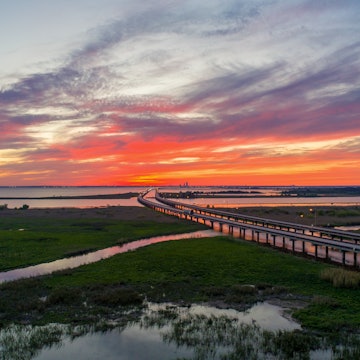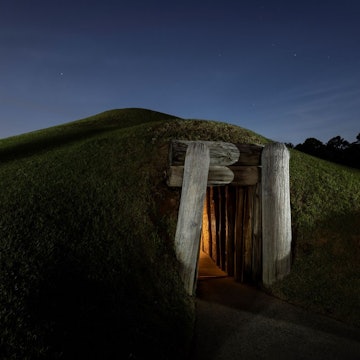

Visitors can traverse the park’s 28 miles of trails © Gulf State Park
Nearly ten years after the catastrophic Deepwater Horizon oil spill, it’s not only humans who are reaping the benefits of a vastly-improved state park along the Alabama shore. So, too, are the songbirds and the sea turtles.

Recovering from disaster
Five states were devastated as 135 million gallons of oil belched into the Gulf of Mexico after the Deepwater Horizon offshore oil platform exploded and sank in April 2010, killing 11 workers. The beaches of Gulf Shores and Orange Beach were harder hit than any others, and Gulf State Park sits right between the two towns.
‘Just imagine getting a can of motor oil … and you poured it out on the beach. But this was like you poured out a bunch of 55-gallon drums,’ said Herb Malone, CEO of Gulf Shores & Orange Beach Tourism.
‘I tell ya’, I’ve never seen as many tears being shed around town as I saw during the oil spill,’ he said.
Almost a decade later, Malone said he still gets puzzled looks when he uses the words ‘Alabama’ and ‘beach’ in the same sentence. Yet the miles and miles of once-again-sugary-white sand are by far the Southern state’s biggest tourist attraction.
Visitors began returning in 2011, but it wasn’t until late 2018 people could fully appreciate the incredible enhancements to the state park, including the new Interpretive Center and an expanded system of trails. The hefty cost – $143 million – was covered by payments from BP, the multi-national oil company that operated Deepwater Horizon.

A turnaround for turtles
The jewel in the park’s crown is The Lodge at Gulf State Park, a warm and welcoming 350-room hotel separated from a secluded stretch of beach by rolling sand dunes in which sea turtles nest each year.
The reptiles’ plight is shared through Turtle Tracks, a work of art that takes up nearly an entire wall in the lodge’s inviting lobby. One of a variety of original works by Alabama artists, the four pieces of fiberglass, molded by April Hopkins of Mobile, feature trails in the sand made by the turtles’ flippers.
In the past, baby turtles were regularly being run over by cars along Beach Blvd after heading in the wrong direction when they left their nests.
‘Sea turtles are very easily disoriented by white lights. They were getting distracted by street lights, parking lot lights, pool lights, and going to the street instead of going to the Gulf,’ said Chandra Wright, the lodge’s Director of Environmental & Educational Initiatives. She’s also a volunteer with Share the Beach, a non-profit that monitors sea turtles in the dunes.
As Wright explained, the hotel is using alternatives to typical white lights in its outdoor spaces to make sure the babies head to the water instead of going towards the road.

Protecting all the park’s flora and fauna
Lighting is just one of many eco-friendly practices integrating the lodge with its surroundings. It’s on track to obtain LEED Gold certification thanks to its sustainable design, which was overseen by architect Matt Leavell and his team from the University of Alabama Center for Economic Development.
‘The building is set back further from the water than most of the other buildings,’ Leavell said in a reference to the scads of beachfront hotels and condos in the nearby towns. The lodge’s positioning allows for the dunes to naturally expand over time, providing a growing habitat for various flora and fauna.
Not so obvious are subtle touches such as the patterned film that coats the hotel’s windows. While difficult for humans to see – even when they’re looking for it – the pattern is easily visible to approaching birds, averting deadly collisions with the glass.
Enticing woodland wonders
Although sun-kissed sand is the key attraction at other hotels, Leavell said lodge guests are enjoying the woods as much as the beach.
Getting to those woods, and the freshwater lakes beside them, is as easy as walking out the front door: 28 miles of biking and hiking trails begin across the street.

New this summer, a free-for-all bike share program is one of the scores of projects funded by Deepwater Horizon money. Visitors can use an app to check out bicycles from four stations, including one outside the hotel.
Along the routes, which include boardwalks through marshes and paved trails through towering pines, travelers discover a bounty of interpretive signs that explain their surroundings.
‘It’s one of the most special environmental places on the Gulf of Mexico, if not the whole world,’ Wright remarked.
Tucked away in the woods, guests can opt for quieter, more remote lodgings either in the form of rustic cabins or upscale cottages that are also part of the 6150-acre state park.
A short walk or cycle from these self-catering accommodations, visitors will find the park’s new Learning Campus, where one-day and overnight educational programs are offered year-round. Nearby, hungry visitors can grab a meal at the Woodside Restaurant.

A coastal classroom
Set beside a beach pavilion east of the lodge, the Interpretive Center is described as the park’s ‘coastal classroom.’ Open year-round with no admission fee, its exhibits include a unique water feature. During not-infrequent rainstorms, water runoff from the roof courses through a series of troughs and basins before being captured in an 11,000-gallon recycling tank.
‘The story of nature and outdoors needed to be told more,’ Leavell said.
Alabama’s public perception as a poor state, he admits, probably keeps it from being front-of-mind as a vacation destination. But given the chance, he says visitors will find plenty to love on Alabama’s coast.
‘People have stereotypical notions about Alabama,’ he said. ‘This project was about standing up and saying, ‘We’ve got things people can be proud of around here.’ ’
You may also like:
Launching into North Alabama: exploring Huntsville and beyond
Take a hike: 5 natural escapes in Alabama
When is the best time to visit US and Canada’s National Parks?
Make the most of your travel with sightseeing tours and activities from our trusted partners.















